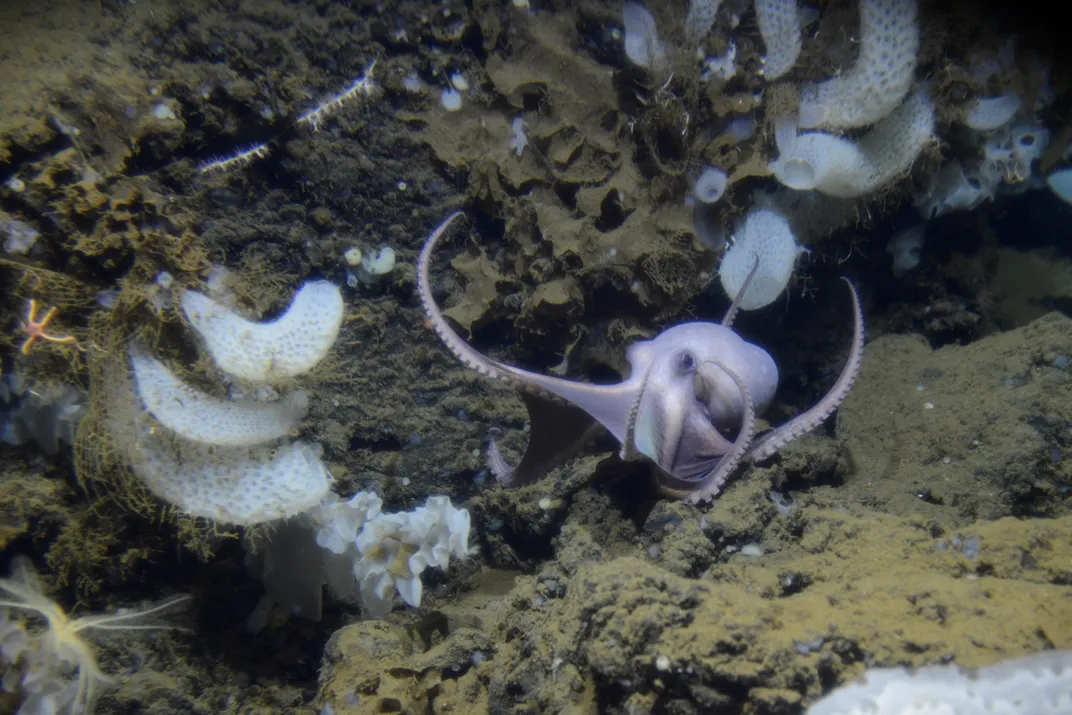Colony of Beautiful, Doomed Purple Octopuses Found Off Costa Rica
Hundreds of unidentified cephalopods were found nursing their eggs near a deep-sea vent
/https://tf-cmsv2-smithsonianmag-media.s3.amazonaws.com/filer/d0/a5/d0a5641e-baab-491b-8644-7fccaeb96d3e/purple_pie.jpg)
In 2013, a team of geochemists off the Pacific coast of Costa Rica sent underwater vehicles to explore the Dorado Outcrop, a rocky patch of seafloor 150 miles from land. They hoped to gather samples of warm water emerging from hydrothermal vents in the hardened lava making up the outcrop. But, as Mindy Weisberger at LiveScience reports, they were stunned by the images that came back from two miles below the waves: hundreds of beautiful purple octopus mamas huddled around the vents, incubating their eggs.
The chemists shared the find with deep sea biologists, who were stunned. “When I first saw the photos, I was like, 'No, they shouldn't be there! Not that deep and not that many of them,” Janet Voight, associate curator of zoology at the Field Museum of Natural History in Chicago says in a press release. She is co-author of a study on the curious creatures that appeared this week in the journal Deep Sea Research Part I: Oceanographic Research Papers. "Never would I have anticipated such a dense cluster of these animals in the deep sea," she says.
From there the mystery only deepened. While the researchers did not formally describe or name the new cephalopods, they did determine that they belonged to an undiscovered species in the genus Muuscoctopus. Typically, octopuses in that group are loners, so it was surprising to see them grouped together.
Unfortunately, it also turned out this beautiful group of mothers was doomed. Voight tells Nathanial Scharping at Discover that the fate of a female octopus is already somewhat tragic; they only breed once in their life, putting all their energy into producing eggs. Once the eggs are laid and affixed to a rock or other hard structure, they spend the rest of their failing energy protecting their clutch of eggs, dying soon after their offspring swim away.

But Voight found that the developing octopus embryos couldn’t make it in the conditions near the volcanic vents the group had chosen. Warm water welling up from the volcanic cracks tends to speed embryo development. But that creates a larger demand for oxygen, which is in short supply around the vents. “As the embryos start to develop from fertilized cells, they’re increasing their oxygen use … and they’re confronted with less oxygen available,” she tells Scharping. “I don’t see how they can possibly survive.”
After examining 186 of the eggs via images from the submersible, she didn’t find a single one with a developing embryo. Which begs the question: why would so many octopuses choose such a terrible spot to nurse their eggs?
According to the press release, much of the Dorado Outcrop may be an awesome place to raise an octopus family, with ideal spots for laying clutches in other cracks and fissures in the hardened lava. But those spots may have been full, and so this unfortunate group of mothers was forced to choose a less than ideal nursery. It's also possible that the fissures were not as active when the octopuses laid their eggs, reports Weisberger. The warm water and low oxygen could have come later.
Adding to the intrigue is the fact that hydrothermal vents are one of the most intriguing and least studied systems on Earth. The vents, where hot, mineral rich water warmed by magma flows deeper underground pours through cracks in the ocean floor, were only discovered in 1977. Since then, researchers have discovered that they are home to extremophile organisms, like bacteria that can survive incredibly high heat and pressure, which are helping scientists understand what life on other planets may look like.
The new purple octopus is unlikely to be the last surprise found at ocean vents. (In fact, researchers did note some tentacles waving from other, more inviting cracks in the rock.) “This is only the third hydrothermal system of its type that has been sampled, yet millions of similar environments exist in the deep sea,” geochemist Geoff Wheat of the University of Alaska, Fairbanks, and co-author of the study says in the release. “What other remarkable discoveries are waiting for us?”